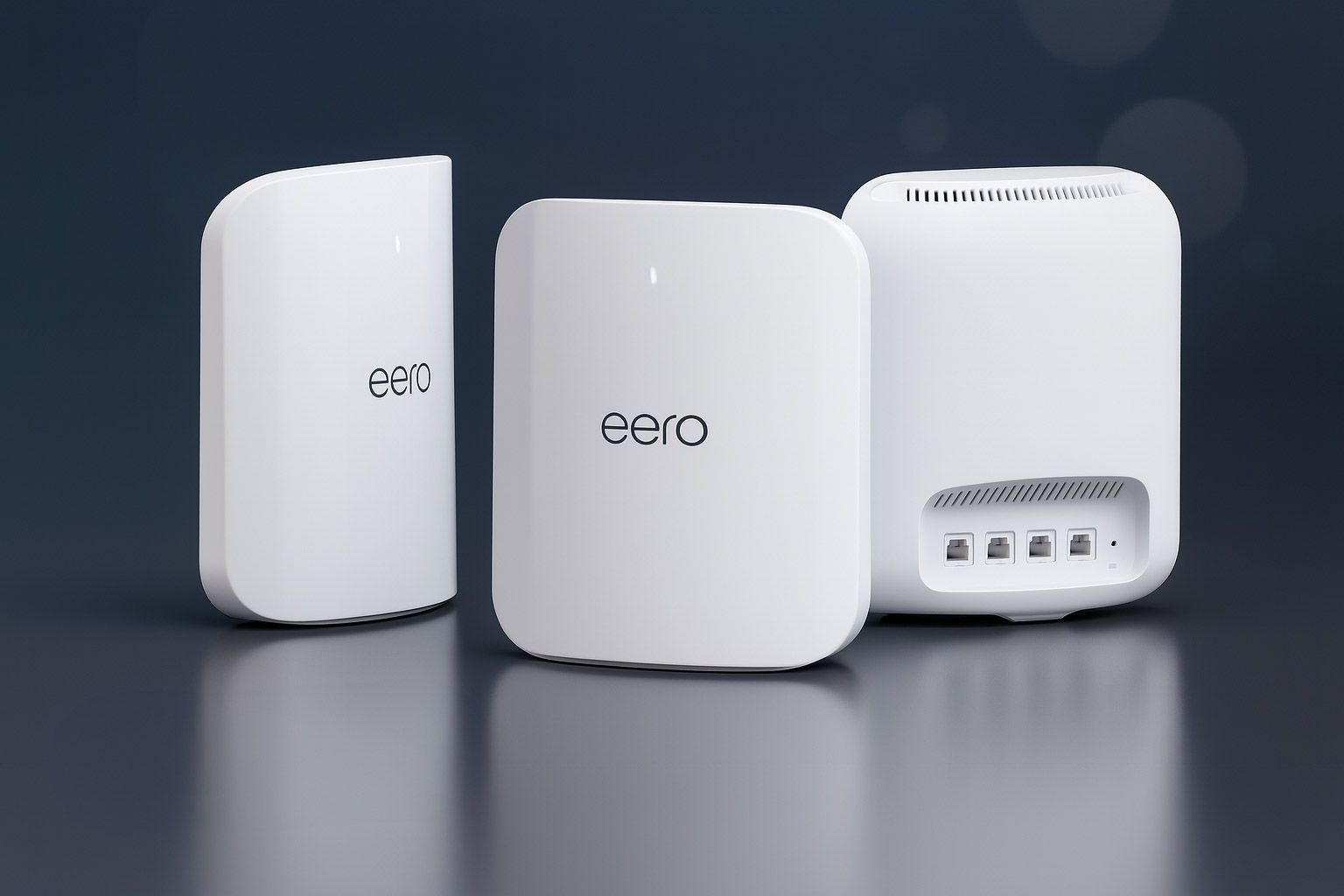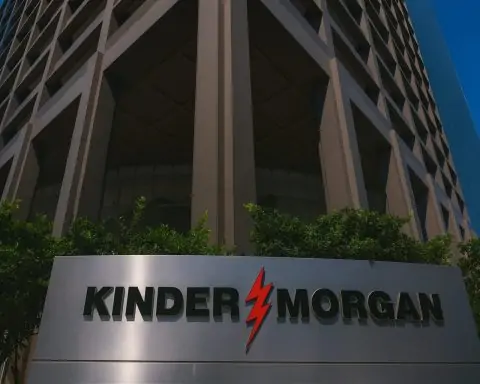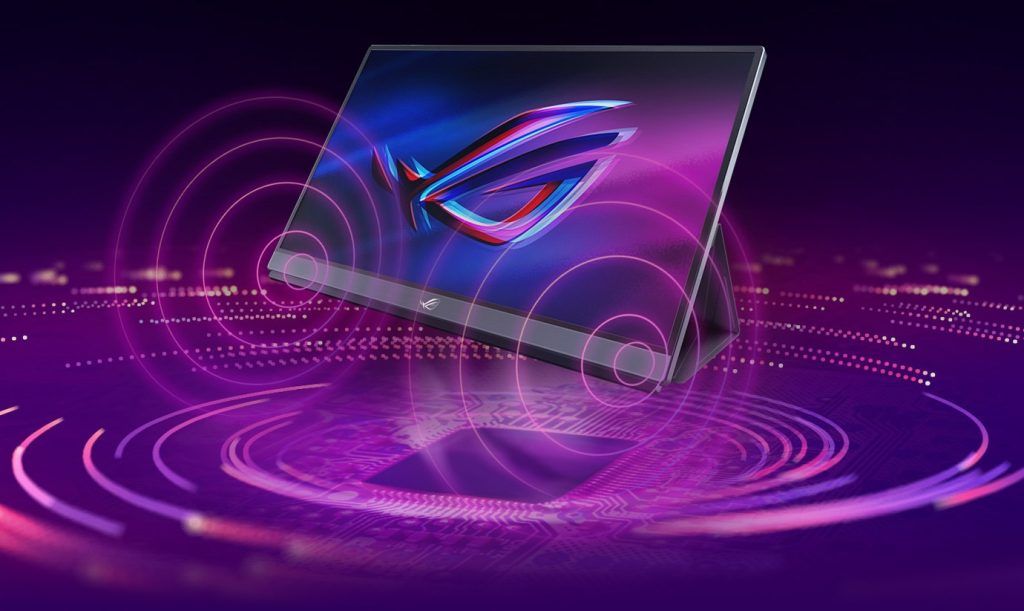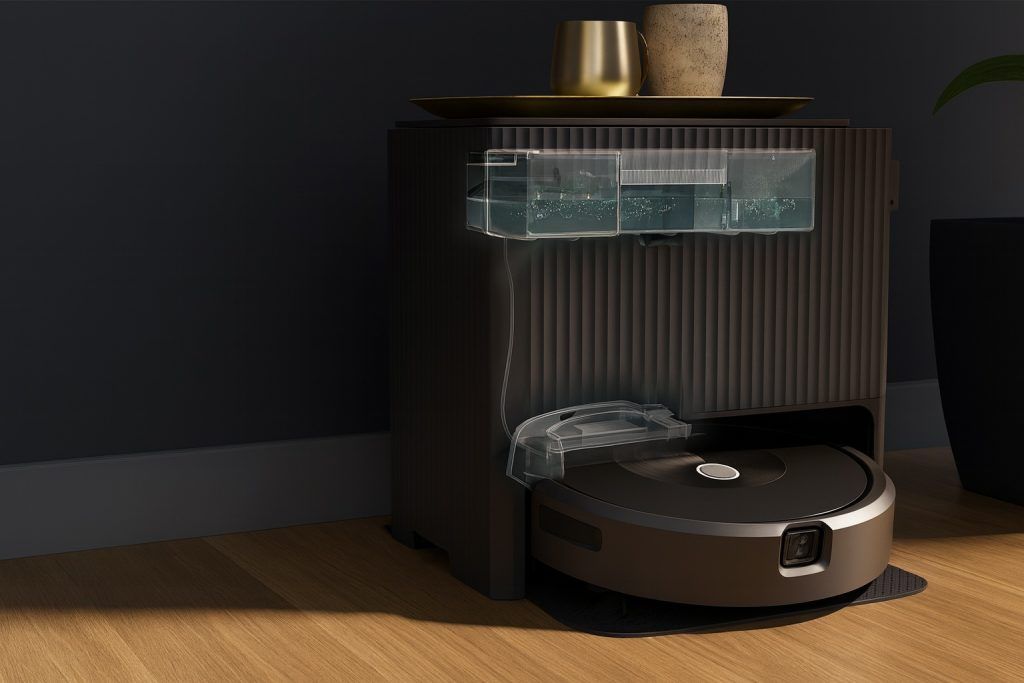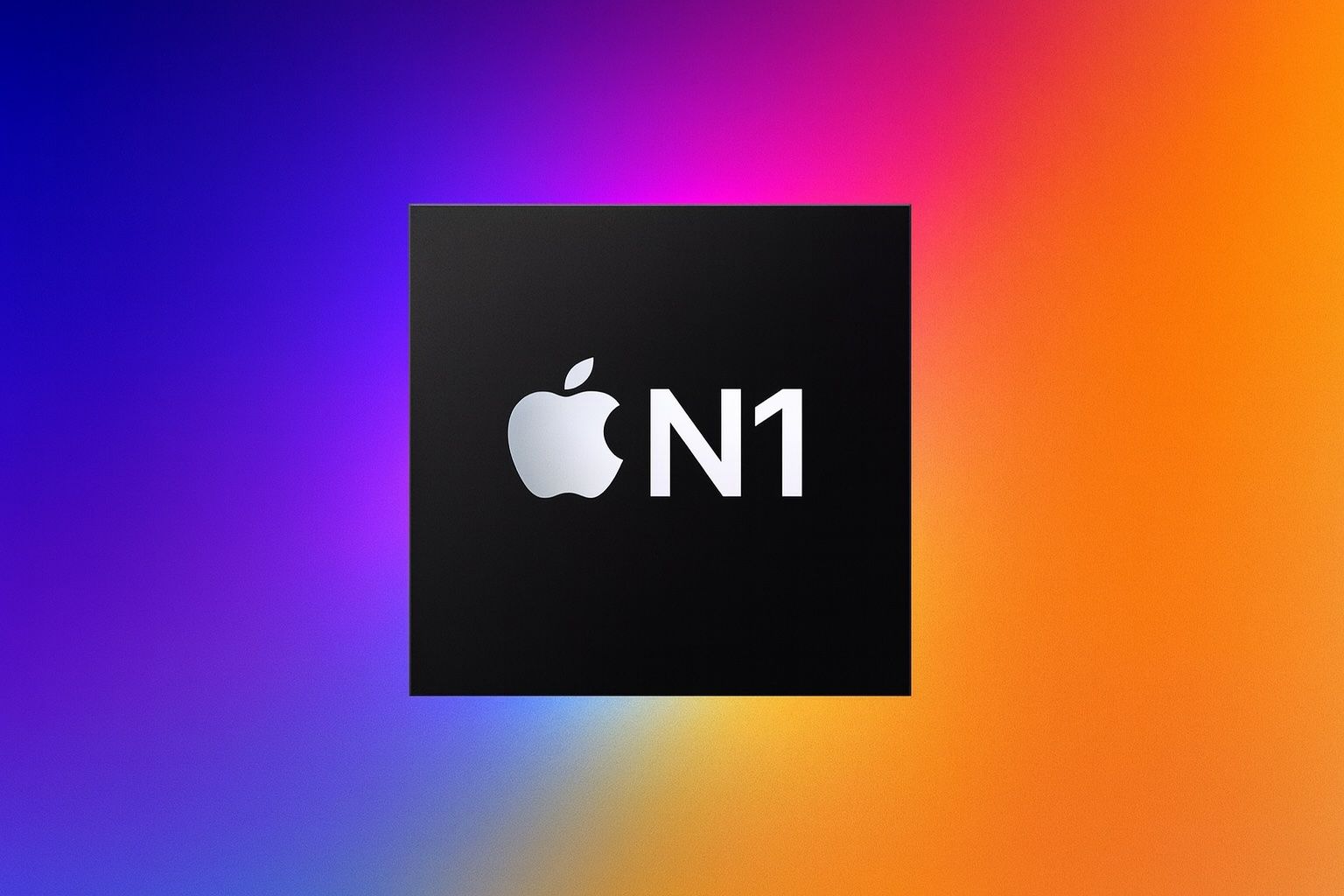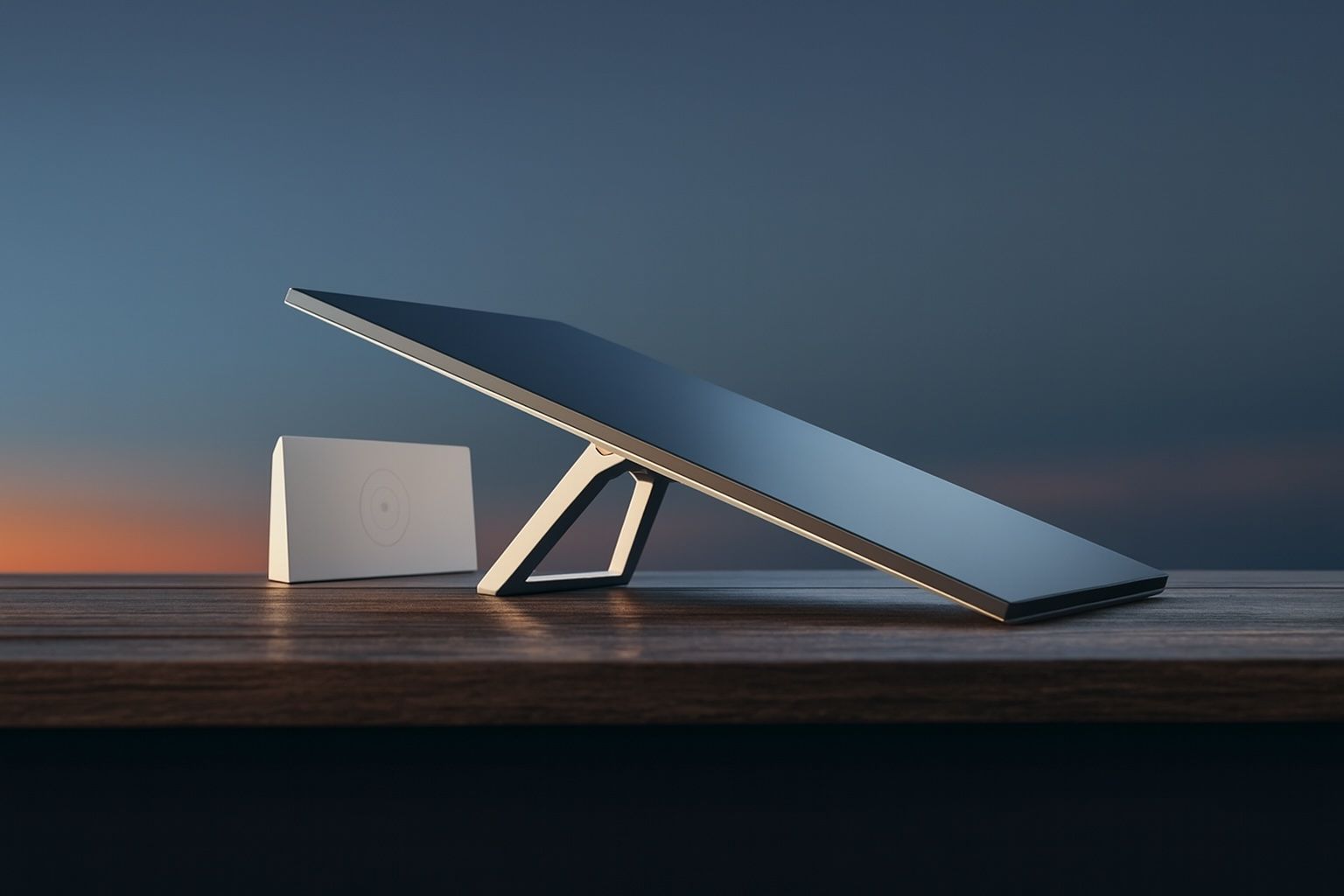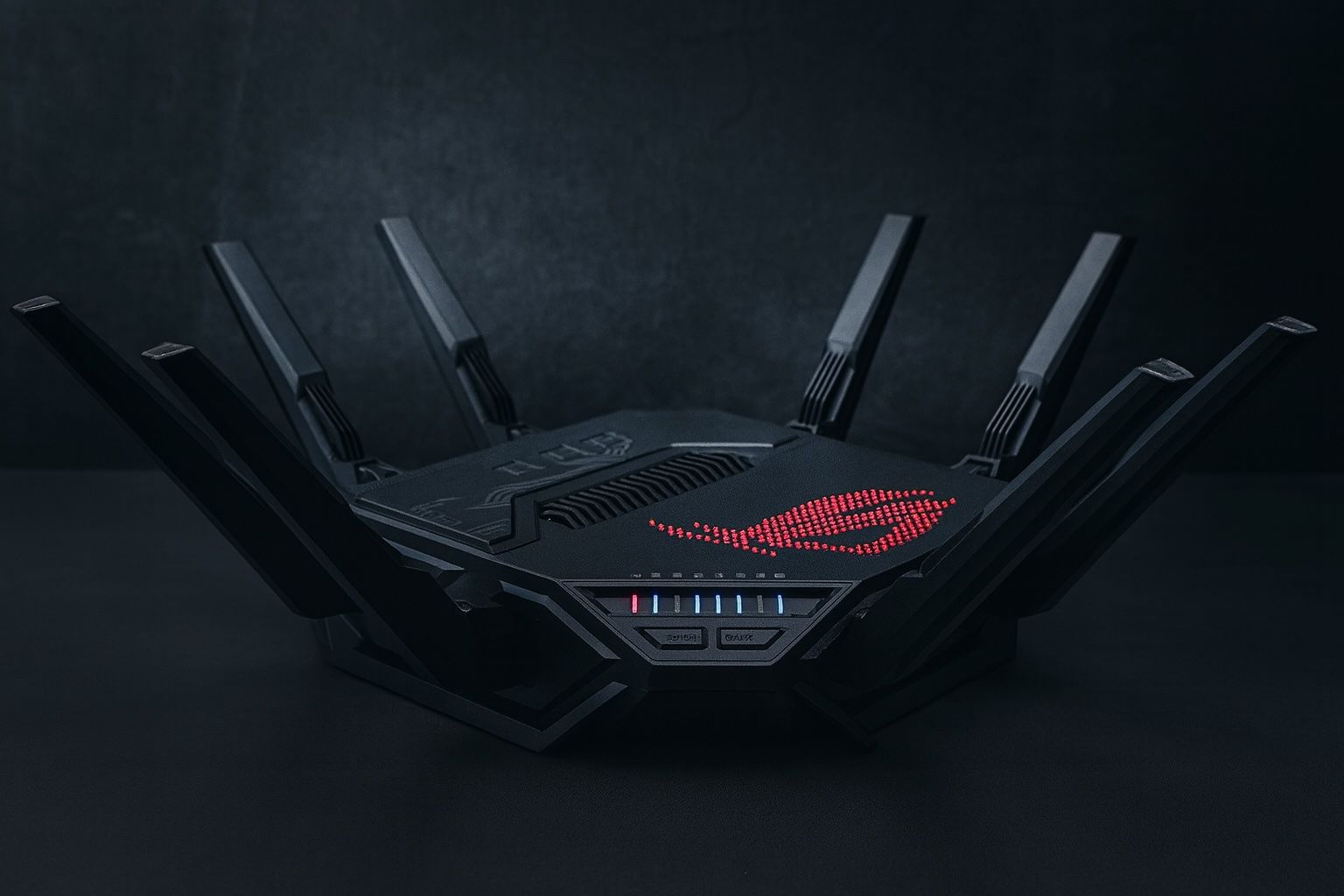- TP-Link Deco BE95 is a quad-band Wi‑Fi 7 system with BE33000 up to 33 Gbps theoretical throughput across four bands, two 6 GHz radios, a 16‑stream (4×4) setup, 12 internal antennas, plus a SFP+ option and a USB 3.0 port.
- The Eero Max 7 is a tri‑band Wi‑Fi 7 router with about 20.8 Gbps combined theoretical throughput (BE20800) and up to 4.3 Gbps wireless link rate to a single client.
- Google’s Nest Wi‑Fi Pro 7 had not been officially announced by August 2025, but is expected to be tri‑band like the current Nest Wi‑Fi Pro 6E, which offered 5.4 Gbps combined throughput, with a Wi‑Fi 7 version likely adding 320 MHz 6 GHz channels and 4K‑QAM.
- In terms of coverage, the Eero Max 7 unit covers about 2,500 sq ft, a 3‑pack covers up to ~6,000 sq ft; the Nest Wi‑Fi Pro 6E covers around 2,200 sq ft per router, with a 3‑pack roughly 6,600 sq ft; the Deco BE95 is rated for about 7,800 sq ft on a 2‑pack, suggesting ~3,500–4,000 sq ft per Deco node.
- Wired backhaul capabilities differ: Eero Max 7 provides four auto‑sensing multi‑gig ports per unit (two 10 Gbps and two 2.5 Gbps); Deco BE95 provides two 10 Gbps ports plus two 2.5 Gbps ports and an SFP+ option; Nest Wi‑Fi Pro 6E historically offered dual 1 Gbps Ethernet ports per unit.
- Design and form factors differ: Eero Max 7 units measure about 7.2 × 8.7 × 3.5 inches and look utilitarian, Nest Wi‑Fi Pro 6E units are around 5 inches in diameter with a compact dome, and Deco BE95 units are tall cylinders about 9.3 × 5.0 × 5.0 inches with a LED ring.
- Backhaul management varies: Deco BE95’s quad‑band design can dedicate a 6 GHz link to backhaul (or use both 6 GHz bands), while Eero Max 7 relies on Amazon TrueMesh with no dedicated backhaul band, and Nest Wi‑Fi Pro 6E uses automatic backhaul management.
- Setup and management are app‑centric for all three; Nest and Eero are cloud‑only with no local web UI, while Deco BE95 offers a web UI in addition to the Deco app.
- Smart home integration includes Eero Max 7 with built‑in Zigbee and Thread as a Matter controller plus Alexa support, Nest Wi‑Fi Pro 6E as a Thread border router with Matter and Google Assistant, and Deco BE95 with Matter/Thread and Alexa/Google compatibility.
- Prices and availability as of August 2025: Eero Max 7 launched in October 2023 at $599.99 for 1‑pack, $1,149.99 for 2‑pack, $1,749.99 for 3‑pack; Deco BE95 launched at CES 2023 with a 2‑pack MSRP around $899.99 (street about $799.99) and single units around $500; Nest Wi‑Fi Pro 6E current pricing is $199 for 1, $299 for 2‑pack, $399 for 3‑pack, with Nest Wi‑Fi Pro 7 pending and pricing likely similar per unit.
Wi-Fi 7 is here, and a new generation of mesh routers promises blazing speeds and better connectivity for our increasingly connected homes. Three standout systems leading the charge are Amazon’s Eero Max 7, Google’s upcoming Nest Wi-Fi Pro (Wi-Fi 7), and TP-Link’s flagship Deco BE95. Each targets the cutting edge of home networking, from multi-gigabit wired links to integrated smart home hubs. This report compares these three Wi-Fi 7 mesh routers across all major aspects – wireless performance, coverage, hardware specs, design, mesh capabilities, user experience, smart home integration, security features, pricing, and expert reviews – to see which one might be the best fit for you.
Wi-Fi 7 (IEEE 802.11be) is the latest wireless standard officially certified in early 2024. It introduces the 6 GHz band and technical innovations like extremely wide 320 MHz channels, 4096-QAM modulation (4K-QAM), and Multi-Link Operation (MLO) that allow devices to use multiple bands simultaneously. These enhancements can deliver dramatically higher throughput and lower latency than Wi-Fi 6/6E. All three routers in this comparison support Wi-Fi 7’s capabilities, but they implement them differently – with varying numbers of bands, antenna configurations, and backhaul strategies – leading to some stark differences in real-world performance and user experience. Below, we break down the comparison category by category.
Wi-Fi 7 Technology and Performance
Wireless Speed Potential: On paper, the TP-Link Deco BE95 is the most extreme of the trio. It’s a quad-band Wi-Fi 7 system that TP-Link advertises as “BE33000,” meaning up to a 33 Gbps combined theoretical throughput across its four bands. The BE95 has two 6 GHz radios (each up to ~11.5 Gbps), plus a 5 GHz (up to ~8.6 Gbps) and 2.4 GHz band. By contrast, the Eero Max 7 is a tri-band Wi-Fi 7 router (2.4, 5, 6 GHz) with a combined theoretical rating around BE20800 (~20.8 Gbps) – supporting up to 4.3 Gbps maximum wireless link rate to a single client. Google’s Nest Wi-Fi Pro (Wi-Fi 7) has not been officially announced as of August 2025, but it’s expected to remain a tri-band design similar to the current Nest Wi-Fi Pro (which is Wi-Fi 6E). The Wi-Fi 6E Nest Pro touted 5.4 Gbps combined throughput [1]; a Wi-Fi 7 version will likely exceed that by adding 320 MHz channel support on 6 GHz and 4K-QAM modulation for ~20% higher data rates. In short, all three support Wi-Fi 7’s headline features (320 MHz channels, 6 GHz band, MLO, etc.), but Deco BE95 has the highest raw wireless capacity on paper – roughly double that of the Eero Max 7 or Nest Wi-Fi – thanks to its extra 6 GHz radio and 16 total spatial streams.
Real-World Throughput: Of course, theoretical speeds rarely reflect practical performance. In testing, the TP-Link Deco BE95 has delivered multi-gigabit Wi-Fi speeds in real homes. TP-Link’s own trials (with Wi-Fi 7 clients) showed wireless throughput in the 5–8 Gbps range in rooms near a Deco unit, even using wireless backhaul between two units. This is an astonishing level of Wi-Fi performance – reviewers have called the BE95 a “powerhouse” built for “bleeding-edge performance” [2]. The Eero Max 7, on the other hand, has shown more modest results. In fact, some early reviewers found the Eero’s Wi-Fi performance underwhelming given its Wi-Fi 7 label. Dong Knows Tech reported that if you have “high hopes for top-notch Wi-Fi speeds, the Eero Max 7 will disappoint”, calling its real-world wireless throughput “terrible” for the price. (In Dong’s tests, the 6 GHz band was elusive and delivered much lower gains than expected.) On a more positive note, Eero’s mesh managed to maintain solid speeds at long range – RTINGS found the Max 7’s range performance “superb,” with its satellites helping sustain consistent speeds throughout a home. As for Google’s Nest Wi-Fi, the current Wi-Fi 6E model already provides fast connectivity for everyday use (e.g. easily 500+ Mbps to devices), but it lacks the multi-gigabit peaks seen in Wi-Fi 7 tests. We’ll have to wait for the Wi-Fi 7 Nest units and see if Google can approach the Deco’s class-leading throughput or if it will prioritize affordability over raw speed.
Coverage and Range: In terms of coverage, all three systems can blanket a typical large home, but their specs differ slightly. Each Eero Max 7 unit is rated to cover about 2,500 sq ft of area. A 3-pack Eero kit is advertised for up to ~6,000 sq ft of coverage. The Nest Wi-Fi Pro (6E) covers around 2,200 sq ft per router [3], so a future tri-band Nest Wi-Fi 7 will likely be in that ballpark as well (a 3-pack Nest could cover roughly 6,600 sq ft). The Deco BE95 has a higher range rating – TP-Link claims a 2-pack can span 7,800 sq ft, which suggests each Deco node might cover ~3,500–4,000 sq ft thanks to its high-power radios and antennas. In practice, range will also depend on home layout and walls. Notably, reviewers have praised the Eero Max 7’s ability to deliver a strong signal at long distances when used in a multi-node mesh, and TP-Link’s AI-driven mesh steering helps devices roam to the best Deco unit as you move about. All systems support the use of additional nodes to extend coverage if needed (the Eero network supports up to 32 satellites on one network, and the Deco BE95 is backward-compatible with other Deco nodes to expand mesh coverage easily).
Latency and Reliability: Wi-Fi 7’s new features aren’t just about speed – they also aim to reduce latency and improve stability. Multi-Link Operation (MLO) can allow a device to transmit and receive on multiple bands/channels concurrently, which these routers support (Deco and Eero explicitly advertise MLO support). In theory, MLO and the 6 GHz “clean” spectrum should yield more responsive connections (great for gaming or AR/VR). The Deco BE95, with its quad-band design, has the most flexibility to leverage MLO – for example, pairing 5 GHz and 6 GHz links together. In general, users of all three systems report smooth, reliable Wi-Fi for streaming and video calls once things are set up. Google’s Nest Wi-Fi emphasizes network stability through automatic optimizations – it “monitors your network and fixes common issues by itself” to keep performance steady. Eero’s platform similarly is known for intelligently managing the network in the background (though its closed, cloud-based nature means the user has limited insight – more on that later). Overall, for raw wireless performance and range, TP-Link’s Deco BE95 stands out as the most extreme performer (with enough bandwidth to “smoothly stream 8K videos” and more), whereas Eero Max 7 and Nest Wi-Fi will easily handle typical gigabit internet plans and dozens of devices but may not break any speed records in practice.
Hardware Specifications and Design
Bands and Antennas: The routers differ significantly in their hardware design. The TP-Link Deco BE95 is a quad-band Wi-Fi 7 system with a 16-stream setup (4×4 streams on each of four bands) and 12 internal antennas hidden inside. This includes two separate 6 GHz radios – one unique advantage of the BE95 – which can be used for clients or dedicated backhaul. The Eero Max 7 is a tri-band (10-stream) design, with a “2×4×4” antenna array (2×2 MIMO on 2.4 GHz, 4×4 on 5 GHz, 4×4 on 6 GHz). Amazon Eero doesn’t publish antenna counts, but the Best Buy spec sheet confirms the Max 7 supports 2 streams on 2.4 GHz and 4 streams each on 5 GHz and 6 GHz. The upcoming Google Nest Wi-Fi Pro 7 will likely also be a tri-band router; if it follows the current model, it could feature 4×4 MIMO at least on 5 GHz (the 2022 Nest Pro had 4×4 on 5 GHz and 2×2 on 6 GHz, which helped keep cost down). We expect Google’s new router to upgrade to a full 4×4 on 6 GHz for Wi-Fi 7, but that’s speculative. Visually, the Nest units tend to be more compact with fewer antennas – the Nest Wi-Fi Pro (6E) had a smooth, dome-like shape with no visible antennas and came in multiple colors to blend into home decor. It’s safe to assume Google will retain that minimalist aesthetic and internal antenna approach for the Wi-Fi 7 version.
Processing Power: Under the hood, these high-end routers pack robust CPUs and plenty of memory. The Eero Max 7 runs on a powerful Quad-core ARM Cortex-A73 processor with 2 GB RAM and 4 GB flash storage. This is a big jump from previous Eero models and helps it handle the traffic of 200+ devices and new features like encryption and Thread radio. The Deco BE95’s exact chipset isn’t disclosed by TP-Link, but it uses Qualcomm’s Networking Pro platform for Wi-Fi 7 (likely a top-tier SoC given the 16-stream capability). The Deco has enough horsepower to run its AI-driven algorithms (for roaming and mesh optimization) and security scanning without lag. Google hasn’t detailed the Nest Wi-Fi Pro 7’s internals yet; the 6E model used a quad-core ARM processor as well and 1 GB RAM, so the new one should be comparable or better. All three routers support the latest wireless security (WPA3 encryption is standard) and are backward-compatible with older Wi-Fi devices (b/g/n/ac/ax) so all your legacy gadgets will still connect.
Ports and Wired Connectivity: One of the biggest hardware differentiators is the wired I/O. The Eero Max 7 is impressively equipped with four auto-sensing multi-gig Ethernet ports: two 10 Gigabit ports and two 2.5 Gigabit ports on each unit. This marks Eero’s first foray into all-multi-gig hardware, and it means an Eero mesh can support true 10 Gbps wired backhaul and LAN connections (ideal for users with multi-gig fiber or a network attached storage). In fact, any Eero Max 7’s port can serve as WAN; you simply connect one of the 10G ports to your modem and the others become LAN ports. The TP-Link Deco BE95 also caters to multi-gig needs: each unit provides two 10 Gbps ports (one is a 10G Ethernet, the other a 10G combo port supporting either Ethernet or SFP+ fiber) plus two 2.5 Gbps Ethernet ports. That’s a total of four LAN/WAN-capable ports per Deco, similar to the Eero. TP-Link even includes an SFP+ option for those who want to directly hook up fiber – a unique touch for prosumers. The Deco BE95 further features a USB 3.0 Type-A port, which can be used for network storage (e.g. sharing a USB drive or printer). By comparison, Google’s Nest Wi-Fi routers historically have minimal ports. The Nest Wi-Fi Pro (2022) disappointed some power users by including only dual 1 Gbps Ethernet ports per unit (one WAN, one LAN, both limited to 1 Gbps). This was a bottleneck, since the Wi-Fi could exceed 1 Gbps but the wired backhaul could not. For the upcoming Nest Wi-Fi Pro 7, we anticipate Google may address this by at least offering a 2.5 Gbps WAN port (to support faster internet plans) and possibly a multi-gig LAN. However, until specs are announced, it’s uncertain – it’s possible Google will stick to a simpler (and cheaper) dual-gigabit design, aiming at average consumers who mostly use wireless.
Physical Design & Aesthetics: Each system takes a different approach to design. Eero Max 7 units are relatively large and utilitarian – each router measures about 7.2 × 8.7 × 3.5 inches, making it the largest Eero to date [4]. It has a low-profile, flat body in a white finish, with vents on the underside for cooling [5]. There’s no flashy styling; it’s meant to be unobtrusive, though some users noted it’s bigger than expected for an Eero. Google Nest Wi-Fi Pro units, by contrast, are known for their compact, glossy design with rounded curves. The current models are about 5 inches in diameter, with a smooth pebble-like look that’s intentionally decor-friendly. Google offered multiple color options (snow white, light blue, beige, and lemongrass green) for the Nest Wifi Pro to match home interiors. We expect the new Nest Wi-Fi Pro 7 to maintain that “design to look good anywhere” ethos – likely a sleek, minimalist plastic shell with hidden status LEDs and no visible antennas. TP-Link’s Deco BE95 sticks with the Deco line’s familiar cylinder tower design. Each unit is a tall, upright cylinder (about 9.3 × 5.0 × 5.0 inches) in a matte white finish. The BE95 units have a subtle LED light ring and a perforated lower section for heat dissipation. There are no external antennas, giving it a clean look. They are a bit chunky, but the design is “clean, modern, and minimalistic” for a high-performance device. In summary: if you value style and a smaller footprint, the Nest Wi-Fi has the edge in aesthetics; the Deco BE95 is larger but still modern-looking; and the Eero Max 7 is functional and solid, if not particularly decorative.
Mesh Networking Capabilities and Backhaul
All three systems support multi-unit mesh networking to eliminate dead zones, but they differ in how they handle the communication between those units (the “backhaul”). Wired backhaul (connecting the nodes via Ethernet) is the optimal method for any mesh, and all three support it – in fact both Eero and TP-Link encourage using their multi-gig ports for backhaul to unlock maximum performance. But many users will deploy these in wireless mesh mode, where the routers must dedicate some Wi-Fi capacity to linking with each other.
Eero Max 7 Mesh: The Eero uses Amazon’s proprietary TrueMesh technology to dynamically manage backhaul and client connections across the 2.4, 5, and 6 GHz bands. However, since it’s only tri-band, it does not have a separate dedicated backhaul band. The Eero will automatically decide whether to route data between nodes on 5 GHz or 6 GHz (or even 2.4 in rare cases) depending on signal quality and traffic – all under the hood. This simplicity is good for ease of use, but it means in a pure wireless setup the backhaul will consume part of the same spectrum your devices use. In practice, the Eero Max 7’s wireless backhaul has been reported as a weak point. Dong Ngo’s testing noted “sub-par wireless backhauling” on the Max 7 – the throughput between Eero nodes over Wi-Fi was underwhelming compared to competitors. With no dedicated channel, heavy inter-node traffic can reduce capacity for clients. The upside is that Eero’s 10 GbE ports allow for daisy-chaining units with 10 Gig links – if you wire your Eeros via Ethernet (or even 2.5G), you get full use of each band for clients and can achieve multi-gigabit actual speeds on devices. In a wired backhaul setup, Eero Max 7 can truly shine (it delivered a “real 10 Gbps network right out of the box” in one reviewer’s wired tests, sustaining ~6 Gbps throughput per 10G port in practice). But if you plan to run an all-wireless mesh, Eero’s advantages diminish. Essentially, Eero Max 7 is best for those who can leverage Ethernet backhaul; otherwise, its tri-band Wi-Fi 7 might not outperform a Wi-Fi 6E mesh by as much as you’d expect.
Nest Wi-Fi Pro Mesh: Google’s Nest Wi-Fi systems have always focused on ease rather than hardcore specs. The Nest Wi-Fi Pro (2022) was tri-band (2.4+5+6 GHz) with no dedicated backhaul radio – similar to Eero – and it relied on the system to figure out the optimal band for backhaul. Google’s mesh algorithms ensure a single SSID and seamless roaming, and they tend to favor simplicity (there’s no way for users to manually, say, force backhaul on 6 GHz only – the system manages it automatically). In practice, Nest Wi-Fi Pro provided reliable whole-home coverage, but in performance benchmarks it lagged behind some higher-end systems that had an extra band for backhaul. We expect the Nest Wi-Fi Pro 7 to follow the same pattern: a straightforward mesh that “just works” with minimal user intervention, but not offering advanced backhaul configuration. If Google continues its design strategy, the Nest Wi-Fi 7 will prioritize robust coverage and device handoff over maximizing speed between nodes. Wired backhaul is supported (you can connect Nest routers via Ethernet and the system will use that for backhaul), which is recommended for demanding setups since the prior Nest units only had gigabit ports. One note: older Google Wifi systems had a limitation of one primary router and multiple secondary points, but the Nest Wi-Fi Pro uses all identical routers and does allow multiple units wired to a switch. In fact, a December 2024 Nest Wifi Pro firmware update improved performance in meshes with Ethernet backhaul, showing Google’s continued optimization of their mesh software. Overall, a Nest Wi-Fi mesh is extremely easy to set up for a layperson – but power users looking to fine-tune backhaul or view detailed mesh metrics might find it lacking in controls.
TP-Link Deco BE95 Mesh: The Deco BE95 is the most flexible of the lot for mesh networking. With its quad-band setup, TP-Link effectively includes an extra 6 GHz band that can be dedicated purely to wireless backhaul if desired. In the Deco app, you can actually configure whether one of the 6 GHz radios (or even the 10G Ethernet) is reserved as a backhaul, or let the system combine them. Deco also supports combining wired and wireless backhaul simultaneously for maximum throughput – TP-Link notes that each BE95 unit can use a wired link plus a wireless link at the same time to boost the inter-node bandwidth [6]. Using MLO, the Deco can aggregate backhaul capacity across two channels. This makes the BE95’s mesh backhaul extremely robust: even without wires, a two-unit BE95 mesh was shown sustaining around 5 Gbps through the house over the wireless link alone [7]. And with a 10G wired backhaul, it basically retains full speed (8–9 Gbps between nodes) everywhere. In short, TP-Link’s quad-band design gives it an inherent advantage for mesh performance – one 6 GHz can serve clients while the other 6 GHz is a dedicated high-speed highway between mesh nodes (or it can even use both 6 GHz bands for clients if you’ve wired the nodes). No other consumer mesh system apart from more expensive enterprise-grade setups offers this in 2025. The Deco also supports EasyMesh (the standards-based mesh interoperability), though mixing with non-Deco hardware isn’t common – more useful is that it’s backward-compatible with older Deco units, so you could repurpose a Deco X90 or X50 as an extra node in less critical areas if needed.
In summary, for mesh flexibility: Deco BE95 clearly leads – it’s designed to excel in wireless-backhaul scenarios and can practically match wired-like speeds throughout a large home [8]. Eero Max 7 offers a stable mesh and great range, but really unleashes its performance on wired backhaul (its wireless mesh links are more average). Google Nest Wi-Fi will deliver perfectly adequate mesh coverage for most households without any tweaking, but it’s the least configurable and, if past is prologue, will not prioritize raw inter-node bandwidth the way TP-Link does.
Ease of Setup and Management
One of the most important aspects for everyday users is how easy the system is to install and manage. All three vendors promise simple app-based setup and minimal hassle, but there are differences in user experience and control.
Setup Process:Google Nest Wi-Fi probably wins for simplicity – using the Google Home app, setting up Nest routers is very newbie-friendly. You scan a QR code and the app adds the device to your Google Home, then guides you through naming your Wi-Fi network, etc. Google’s system is designed so that “most users can be up and running in minutes”; it also adds helpful touches like proactively testing the mesh connection between units and suggesting better placement. The Nest Wi-Fi Pro automatically optimizes channel settings in the background, so there’s little to manually configure. Eero Max 7 setup is similarly straightforward: the Eero app also uses a QR code (printed on the unit) for quick onboarding. You do need an Amazon account (or Eero account) and an internet connection to initialize it [9], as Eero devices must phone home to register. Once online, the app handles firmware updates and will walk you through adding additional Eeros. Eero’s app is polished and has helpful features like a placement guide and device connection map, making the initial mesh setup quite painless – one reviewer was able to install a 3-pack in under 30 minutes, including the extra nodes [10] [11]. TP-Link Deco BE95 setup uses the Deco mobile app (Android/iOS). The process involves creating or logging into a TP-Link account, then the app finds the Deco and steps you through naming the Wi-Fi and placing satellites. Reviewers note the Deco app is very user-friendly; even advanced hardware like the BE95 can be set up in “under 20 minutes” by a non-expert [12]. The app includes a visual guide to optimize node placement and will automatically handle linking the nodes together. TP-Link does not strictly require a cloud account for basic setup – you can choose local control – but the app will encourage logging in for remote management features.
Day-to-Day Management: Here’s where the philosophies diverge. Eero and Nest Wi-Fi are both app-only systems with no local web interface for advanced configuration (Eero has no web UI at all; Google has none for Nest). This means all settings and monitoring are done through the mobile app. The interfaces are simple and relatively limited – for example, Eero does not offer customizable QoS or detailed traffic stats. In fact, the Eero Max 7’s app still “feels like” older Eeros; Dong Ngo observed that the app hadn’t even been updated to fully recognize Wi-Fi 7 in some text, indicating a somewhat stagnant feature set [13] [14]. The Eero app is very easy to use for basics (like creating a guest network, pausing a device’s internet, or checking what devices are connected), but advanced users might be frustrated by the lack of fine-tuning. You cannot, for instance, manually split bands or adjust channel widths on Eero – it’s all automated. The Google Home app for Nest Wi-Fi similarly exposes only straightforward settings. You can group devices into “Family Wi-Fi” profiles and schedule internet breaks, but you won’t see per-device throughput graphs or be able to manually select channels. Google assumes you’d rather let the system handle things with its “proactive network management”. The Nest does at least automatically prioritize certain traffic (video calls, streaming) in the background, whereas Eero notably has no user-facing QoS settings at all (QoS is effectively always auto-managed).
TP-Link Deco strikes more of a balance between user-friendliness and advanced control. The Deco app is clean and simple for novices, but TP-Link also provides an optional web management interface for those who want more control [15]. Through the web UI or advanced menus, users can tweak things like band steering settings, channel selection, transmit power, etc. The Deco app also includes network optimization scans and more detailed info on client signal quality. This makes Deco BE95 more appealing to power users – you get the ease of app setup, but you aren’t forced to use the cloud or mobile app for every configuration task. By contrast, Eero is 100% cloud-dependent: you must use the app (with an internet connection) to manage it, and there’s no way to even log into the router locally via a browser [16] [17]. Google’s Nest also requires linking to a Google account and controlling via Google Home app (again, cloud-tied).
Updates and Maintenance: All three routers receive firmware updates to improve features and security. Amazon Eero pushes firmware updates automatically (and notably does not allow opting out – auto-updates are mandatory) [18]. Eero releases updates fairly regularly, and the Max 7 being new has already gotten some stability patches since launch (though Amazon doesn’t publish detailed release notes to the public). Google Nest Wi-Fi updates automatically as well – Google usually rolls out a new firmware every few months. For instance, an update in July 2025 (version 3.76) for the Nest Wifi Pro addressed some setup issues and improved mesh reliability. These updates happen in the background and Google’s app will simply notify when new software is installed. TP-Link Deco allows a bit more user control: you can set updates to auto-install or choose to apply them manually via the app. TP-Link has been actively updating the BE95 – notably, they added the promised Matter support via a firmware update in 2023. Some early adopters had questioned delays in enabling certain features (like use of the second 6 GHz band for clients), but TP-Link has been responsive in rolling out improvements. The Deco app makes it easy to keep an eye on firmware and trigger updates when convenient.
In terms of reliability, each system is relatively hands-off. Eero and Nest are designed to require virtually no rebooting or tweaking by the user – in fact, both lack a traditional “reboot” button in the app (you rarely need to restart them unless troubleshooting). The Deco BE95, being bleeding edge, had a few early firmware quirks (some users reported needing an occasional reboot every few months), but generally it’s been stable for most, and TP-Link’s AI mesh algorithms help maintain a solid link. All three support standard router functions like DHCP, NAT, port forwarding, etc., but if you need advanced networking settings (custom VLANs, static routes, etc.), none of these is as configurable as an enterprise router. They are consumer mesh systems first and foremost. The Deco comes closest to prosumer features, and it even supports running in Access Point mode or as part of TP-Link’s Omada system for business, whereas Eero and Nest are strictly routers for home use (Nest Wi-Fi cannot run as pure AP without using its routing functionality, though you can put it in bridge mode with limitations).
Software Features and Security
Beyond raw hardware, the ecosystem and features each router provides can be a deciding factor. This includes parental controls, security services, and smart home integration.
Parental Controls: Google takes a clear lead in offering robust parental controls at no extra cost. The Nest Wifi system allows you to create profiles for your kids’ devices and schedule internet time-outs or bedtime offs. You can also “block access to certain websites and explicit content” through Google’s filters – all included in the standard features. This is great for families, and it doesn’t require any subscription. Amazon’s Eero Max 7 also lets you pause devices or schedule offline time via profiles, but for more advanced filtering (like category-based blocking of sites, malware filtering, etc.), Amazon pushes its eero Plus subscription. Eero’s app will frequently remind users about the paid eero Plus service, which can be annoying. With a subscription (~$9.99/month or $99/year), Eero Plus unlocks things like content filters, ad blocking, and even bundled perks (security apps, password manager) [19] [20]. Without subscribing, Eero’s built-in parental controls are quite basic – essentially just pausing and scheduling by profile. This contrast has irked some Eero buyers who feel such features should be free [21] [22]. TP-Link HomeShield is the Deco’s answer to this area. HomeShield Basic (free) gives you standard network scanning for threats, basic parental controls (profile-based site blocking, time limits), and QoS presets. To get the full suite – e.g. detailed usage reports, robust content filtering categories, and the novel KidShield mobile app for tracking kids’ online activity and location – you need HomeShield Pro, which is a paid subscription [23]. TP-Link’s approach is similar to Eero’s: basic protections free, advanced features for a fee. An advantage for TP-Link is that even the free tier includes quite a bit, like WPA3 encryption and real-time IoT protection on the network. The Deco app also allows creating a guest network easily and offers an Away mode to keep security on when you’re remote. Google’s system also has easy guest network support (with the ability to share your guest Wi-Fi via QR code or Google Home app), and it benefits from Google’s safe browsing database for its site blocking feature. In summary, Google Nest Wi-Fi offers the most family-friendly feature set out-of-the-box, Eero and Deco both can achieve similar results but may require a subscription to unlock the full functionality.
Security Features: All three routers support the latest security protocols (WPA3). Deco BE95 and Eero Max 7 go a step further by integrating additional security scanning. The Deco’s HomeShield (Pro) provides antivirus and intrusion prevention powered by TP-Link’s partnership (previous HomeCare used Trend Micro). It can scan for vulnerabilities on connected devices and quarantine threats. Eero, through eero Plus, offers things like malware blocking and even a VPN for when you’re on external networks. Google doesn’t have a branded security suite for Nest routers, but they do automatically update firmware to patch vulnerabilities and use secure boot to prevent unauthorized firmware. Google also leverages its experience from Google Safe Browsing to block known bad websites if you enable that for a profile. Notably, Google and Amazon’s systems are cloud-managed, so some users have privacy concerns: data about your network and device usage is inevitably going through their servers. Dong Knows Tech highlighted that Eero routers “collect user data” by design and won’t function without connecting to Amazon’s cloud [24] [25]. Google’s Nest Wi-Fi similarly requires linking to Google – which, given Google’s business, likely means some telemetry on network performance and connected device types is collected (though Google claims it does not monitor your internet traffic content). If you are privacy-conscious and want a router that can be run completely offline, the Deco BE95 is more accommodating: you can manage it locally and it doesn’t require constant cloud check-in (though some Deco features like cloud sync and remote management do use TP-Link’s cloud, you can opt out). That said, TP-Link’s HomeShield will update threat signatures from the cloud. In any case, each system takes security seriously in terms of hardening the router itself and providing tools to secure your smart home. Google and Eero auto-update firmware (no user action, which is good for security). TP-Link allows auto-updates but also provides release notes and manual control if preferred.
Quality of Service (QoS): Only TP-Link Deco gives an explicit QoS feature to users via the app (you can prioritize certain devices or application types through HomeShield’s QoS settings) [26]. Google’s Nest Wi-Fi automatically prioritizes traffic when it deems necessary (for example, it will detect a video call and ensure that gets priority bandwidth), but there’s no manual QoS toggle. Eero famously has no exposed QoS – the philosophy is that the system manages it invisibly. This works fine for most, but advanced users might wish to, say, prioritize a gaming PC over other devices – that’s not directly possible on Eero. If manual QoS is important to you, Deco BE95 is the only one of these three that offers that configurability out of the box [27].
Firmware Update Frequency: As of August 2025, the Eero Max 7 is still relatively new – Amazon has issued a few updates since its late-2023 launch, focusing on stability (one can hope they’ve improved the 6 GHz performance issues reported at launch). Eero updates are automatic and behind the scenes, usually every couple of months or when new features (or new Eero models) are introduced. The Google Nest Wifi Pro (Wi-Fi 6E), now almost three years old, has seen regular firmware improvements about 2–3 times per year. Google is likely holding any major new features for the next-gen release. The TP-Link Deco BE95 had firmware updates in 2023 that enabled Matter support and improved the usage of its second 6 GHz band (initially it was mainly for backhaul; TP-Link has since allowed more flexibility). TP-Link also updated the Deco app to version 3.0 with a refreshed interface and improved management in late 2024. Users can expect TP-Link to continue refining the BE95, as it’s their flagship – any newly discovered security issues or compatibility problems (say with new Wi-Fi 7 client chipsets) should be addressed via firmware patches.
Smart Home Integration (Matter, Thread, Voice Assistants)
In 2025, a top-tier router isn’t just about Wi-Fi – it often doubles as a smart home hub. Here’s how these three compare in integrating with smart home standards and assistants:
Amazon Eero Max 7: Eero, being part of Amazon’s ecosystem, is built to be a central smart home hub. The Max 7 supports Thread (it has a Thread radio), functions as a border router for Thread devices, and is Matter compatible for controlling Matter smart home gadgets. It even includes a built-in Zigbee hub, a feature carried over from earlier Eeros, which allows it to connect directly to Zigbee devices and bring them into Alexa’s system. In practice, this means you can use Eero Max 7 as the connectivity bridge for Zigbee sensors, bulbs, etc., via the Alexa app – eliminating the need for a separate Zigbee hub. Eero Max 7 also Works with Alexa, meaning you can use voice commands through an Alexa-enabled device to do things like pause the Wi-Fi for certain profiles or enable the guest network. (For example, “Alexa, ask Eero to pause the internet for the kids.”) Because it’s an Amazon product, Alexa integration is seamless, but note that Eero does not have Google Assistant integration – Amazon positions Eero as part of the Alexa smart home. Apple HomeKit users, however, are not left out: Eero routers have supported HomeKit Secure Router functionality in the past, adding an extra firewall layer for HomeKit devices. The Max 7 being so new, it’s expected to either support that soon or already (Eero’s support site indicates Eero 7 routers do work as HomeKit Secure Routers with a firmware update). In summary, Eero Max 7 is a great choice if you have a mixed smart home – with Zigbee, Thread, and Wi-Fi devices – and want a single hub for all. It’s Matter controller capable, which means it can onboard and manage Matter devices across different brands.
Google Nest Wi-Fi Pro 7: Google has been a major player in driving the Matter and Thread standards. The Nest Wifi Pro (6E) launched with full support for Matter and acts as a Thread Border Router out of the box. Google even touted that Nest Wifi Pro units are “built with Matter, the new universal standard” and can connect and control Matter devices directly in the Google Home app [28]. This means a Nest router can function similarly to a smart home hub, bridging Wi-Fi, Thread, and Matter devices together for your Google Home/Assistant ecosystem. Nest Wifi units do not contain Zigbee radios (unlike Eero), so Zigbee devices would need a separate hub or a Matter bridge. But Thread is fully supported – this is important for connecting smart locks, sensors, etc., from brands that use Thread (many of which now can be made Matter-over-Thread devices). With a Nest Wi-Fi Pro in your home, you have a Thread network always available for compatible gadgets. Regarding voice integration, Google’s router naturally works with Google Assistant. While the Nest Wifi (2019) had smart speakers in the points, the Nest Wifi Pro does not include a speaker or mic – but you can use any Google Nest Hub or Nest Mini to voice-command your Wi-Fi (e.g., “Hey Google, reboot the Wi-Fi router” or “Hey Google, pause Wi-Fi for the Living Room TV”). The Google Home app tightly ties your Wi-Fi network into your broader home automation – for instance, you could create a routine where if a certain person’s phone disconnects from Wi-Fi (meaning they left home), the home arm system could activate. And because Google’s ecosystem is broad, the Nest Wifi can interact with Nest cameras, doorbells, etc., ensuring they get priority connectivity. So, for those deep into the Google smart home, Nest Wifi Pro is an excellent fit. It’s also Assistant-ready for voice commands about network status.
TP-Link Deco BE95: TP-Link has embraced the new standards as well – the Deco BE95 supports Matter and includes a Thread radio, effectively letting it act as a Matter controller and Thread border router just like the others. TP-Link added Matter support in early 2023 and provides a neat integration in their Deco app: you can directly add Matter devices through the Deco app’s “Add Smart Device > Matter” menu. This means the Deco BE95 can be a hub for controlling your Matter-compatible bulbs, locks, thermostats, etc. Even if you lose internet, TP-Link notes you can still locally control Matter devices on your LAN via the Deco app, which is a nice reliability touch. In terms of voice assistant integration, the Deco BE95 works with both Alexa and Google Assistant for basic router controls. You can ask Alexa or Google to enable the guest network or tell you the Wi-Fi password, for example. TP-Link doesn’t have its own voice assistant, so they wisely support both major ones. Unlike Eero and Google, TP-Link doesn’t make its own smart speakers or displays, but compatibility with Amazon Echo/Google Home means you can still use voice to manage it. One thing to note: TP-Link also has its Kasa/Tapo line of smart home devices (plugs, cameras, etc.), which are Wi-Fi and now some Matter. The Deco app has a “Smart Home” module that can show and control TP-Link smart devices connected to the network, making the BE95 sort of a central controller for TP-Link’s ecosystem as well. While the Deco BE95 does not have Zigbee, TP-Link has separate hubs for Zigbee if needed. Overall, all three routers have embraced Matter and Thread, signaling a convergence of Wi-Fi networks with smart home networks. This is great news for consumers – it means your router can double as the backbone for your smart home, reducing the need for multiple proprietary hubs. If you have Alexa-based smart home devices and Zigbee accessories, Eero Max 7 might be most convenient (thanks to Zigbee support). If you’re all-in on Google Home and Nest gadgets, Nest Wifi is the natural choice as a Matter/Thread hub inside the Google ecosystem. If you use a mix of devices and want maximum flexibility, the Deco BE95 supporting both Alexa and Google and the latest standards makes it a solid hub-agnostic choice.
Price and Availability (August 2025)
High-end mesh Wi-Fi 7 systems don’t come cheap, and availability can vary as new models roll out. Here’s the state of these three as of August 2025:
- Amazon Eero Max 7 – Available now. It was released in late October 2023 and is being sold as 1-pack, 2-pack, or 3-pack units. The launch price was $599.99 for a single router, $1,149.99 for a 2-pack, and $1,749.99 for a 3-pack. In 2025, we’ve seen occasional discounts (for example, a 3-pack sometimes around $1,499 on sale). But it remains a premium-priced system – roughly $600 per node. You can purchase Eero Max 7 from Amazon (naturally) and other retailers like Best Buy. Given it’s Amazon’s flagship, it’s widely stocked. For those who find the Max 7 overkill, Amazon has also released slightly lower models (Eero Pro 7 and Eero 7) at lower price points, but the Max 7 is the one compared here as it’s the true top-tier with 10G ports. It comes with a 1-year warranty and of course works with Amazon’s support if needed. Being an Amazon product, Prime Day or holiday sales might yield better prices – indeed, Amazon has occasionally bundled Eero with other devices or offered deals to Prime members.
- Google Nest Wi-Fi Pro 7 – Pending release. As of August 2025, Google has not officially announced a Wi-Fi 7 Nest Wifi system yet. However, all signs point to an impending launch. Leaks of an alleged “Nest Wifi Pro 2” (code-name “Breeza”) surfaced as early as late 2023, and Google removed older Nest Wifi products from their store, suggesting a new model is imminent. If Google follows its historical cadence (original Google Wifi in 2016, Nest Wifi in 2019, Nest Wifi Pro in 2022), a 2025 release is due. We anticipate the new Nest Wifi Pro (Wi-Fi 7) will be announced possibly in late 2025. Price-wise, Google has traditionally priced Nest Wifi very aggressively compared to competitors. The current Nest Wifi Pro (Wi-Fi 6E) launched at $199 for one, $299 for a 2-pack, and $399 for a 3-pack, and it’s often on sale for even less. That undercuts the likes of Eero and TP-Link significantly (often half the cost per node). It’s a fair bet that Google will aim for a similar price range with the Wi-Fi 7 version, perhaps $200–250 per unit at retail. Google’s goal is to drive adoption of its ecosystem, so they tend to accept lower margins on hardware. Availability will likely be immediate upon announcement via the Google Store, and major retailers will carry it. If you need a router now, the Nest Wifi Pro (Wi-Fi 6E) is still available (often heavily discounted, e.g. we’ve seen 3-packs for $300 recently). But if you want Google’s Wi-Fi 7, you’ll have to wait a bit. For the sake of this comparison, we’ve assumed the Nest Wifi Pro 7’s existence because it’s widely expected and relevant. Keep in mind that exact specs and price will be confirmed by Google at launch – one should check the latest info if reading after it’s released.
- TP-Link Deco BE95 – Available now. TP-Link announced the Deco BE95 at CES 2023 and it became one of the first Wi-Fi 7 mesh systems you could buy. It is sold in 1-pack or 2-pack kits (and some regions have 3-packs). The 2-pack Deco BE95 debuted at an MSRP around $899.99. As of August 2025, the street price for a 2-pack has dipped to about $799.99. Single units (if you can find them) cost roughly $500. This pricing positions the BE95 as a ultra-premium option – it’s nearly twice the cost of a Nest Wifi Pro 3-pack, for instance. TP-Link justifies the price with the BE95’s cutting-edge tech and high performance, and indeed it’s targeted at enthusiasts or professionals with top-tier needs (multi-gig internet, very large homes, etc.). Availability: The Deco BE95 is sold through Amazon, Newegg, B&H, and other electronics retailers. It comes with a 2-year manufacturer warranty (longer than the 1 year that’s standard for Eero and Google). If $800+ is too steep, TP-Link also offers slightly lower models like the Deco BE85 (tri-band Wi-Fi 7, $499 per unit) and even mid-range Wi-Fi 7 Deco options, as they’ve expanded the lineup in 2024–25. But the BE95 remains the “no-compromise” model. It’s also worth noting that by mid-2025, other brands like Netgear and Asus have their own Wi-Fi 7 mesh or router systems (Netgear’s Orbi 970 series, Asus ZenWiFi Pro series, etc.) – competition is increasing, which might drive prices down slowly. In fact, TechRadar noted in 2025 how Wi-Fi 7 routers have started appearing under $100 (though those are very basic ones), showing how the tech will trickle down. For now, though, the BE95 commands a premium as a state-of-the-art system.
Expert Reviews and Opinions
What do the experts and early users say about these routers? In short: the TP-Link Deco BE95 has wowed testers with its performance (while cautioning about its cost), the Eero Max 7 has drawn criticism for not fully delivering on Wi-Fi 7’s speed promises, and Google’s Nest Wifi (6E) was generally praised for value and simplicity, with anticipation building for the Wi-Fi 7 version.
- TP-Link Deco BE95: Reviews have been very positive about the BE95’s capabilities. Networking reviewers highlight that this system “combines high performance with simplicity and security”. The BE95 earned an “Editors’ Choice” or equivalent from some outlets for being one of the fastest mesh systems available. A tech blogger dubbed it “the ultimate Wi-Fi 7 powerhouse for gigabit homes,” giving it a 9.2/10 score. They noted its pros as “future-proofing with Wi-Fi 7, massive coverage, dual 10G ports, and easy app-based setup,” and the main cons as “very expensive” and overkill for smaller homes. Even on user forums, early adopters have posted eye-popping speedtest results when using BE95 – some saw well over 1 Gbps to phones on Wi-Fi and praised it as the first mesh to truly make Wi-Fi feel like wired in every corner. The only recurring negatives have been the price (clearly) and that some advanced HomeShield features require a subscription [29]. Also, a few experts like Dong Ngo pointed out that the second 6 GHz band being dedicated to backhaul means in single-unit use or wired setups, it was initially underutilized (though TP-Link may allow using it for clients now via firmware). Overall, if money is no object, reviewers agree the Deco BE95 is a top-tier choice for maximum performance – “a monster setup…ready to dominate your wireless needs for years”.
- Amazon Eero Max 7: The reception to Eero’s flagship has been mixed. PCMag and other mainstream reviewers appreciated the Eero Max 7’s class-leading port setup and easy whole-home coverage, but were less impressed with its speed/price ratio. The Eero Max 7 does deliver on providing multi-gig wired networking and very stable mesh coverage, but some tests showed its Wi-Fi speeds, while double an older Wi-Fi 6 system, still lag behind what other Wi-Fi 7 routers achieved. Notably, Dong Knows Tech’s in-depth review was quite negative – titled “Setting the Wi-Fi 7 Bar Incredibly Low,” it lambasted the Max 7 for “firmware that proved to be an unpleasant experience” and “insidious upsell prompts” in the app. He found that the 6 GHz band underperformed and that the device’s emphasis on pushing users into subscriptions and collecting cloud data was off-putting [30]. On the other hand, Rtings.com in their testing noted the Eero Max 7’s strength is its coverage and reliability – saying “it has superb range performance” and that a multi-unit Eero mesh maintains good speeds throughout a home. Many reviewers also like the Eero app’s polish and the robust smart home integration (as one put it, with Eero 7 “you have a reliable and secure smart home hub network to easily control Thread, Zigbee, and Matter devices with Alexa”). Ultimately, experts often conclude that Eero Max 7 is a great fit for those in Amazon’s ecosystem or who value ease of use over absolute performance. But if you’re purely after the fastest Wi-Fi 7 speeds or a ton of router tweaking features, the Eero Max 7 might not satisfy – especially at $600 a pop. It’s telling that in Dong’s comparison, a similarly spec’d TP-Link (Deco BE85) cost significantly less than Eero Max 7 while offering more capabilities. Amazon seems to be charging a premium for the Eero’s user-friendliness and smart home hub functions. For some, that’s worth it; for others, it’s not.
- Google Nest Wifi (Pro 6E and beyond): While we don’t have reviews of a Nest Wifi 7 yet, we can glean from the current model’s reception. Wired magazine praised the Nest Wifi Pro for bringing tri-band Wi-Fi 6E into homes at a very reasonable price, noting it’s a “reliable mesh system that’s easy to use” and calling it a good value for the money. Reviewers liked the slick design and how Google made advanced tech accessible (matter-of-factly, one said it “delivers Wi-Fi 6E without breaking the bank”). However, almost every review mentioned the lack of multi-gig or 10G ports as a downside. Dong Knows Tech, in a review titled “A Wi-Fi 6E Blunder,” criticized that Nest Wifi Pro’s dual 1 Gbps ports were outdated, and he experienced some stability issues in the early firmware. Many tech sites noted that while Nest Wifi is great for typical households, it’s not aimed at enthusiasts – there’s no fancy interface or optimization options, and some experienced a few bugs (which Google has been addressing through updates). As for the forthcoming Nest Wifi Pro 7, tech journalists have been speculating: given Google’s pattern, they expect Wi-Fi 7 support and a soft redesign of the units, plus carrying over Matter/Thread support and maybe introducing at least one multi-gig port. Google has a chance to correct the hardware limitations of the 2022 model. The general opinion is that if Google prices it similarly low, the Nest Wifi 7 could be a extremely compelling mainstream choice – not the fastest, but arguably “fast enough for most and far easier to manage than others.” We’ll have to watch Google’s launch closely. The absence of an announcement by mid-2025 has been noticed – TechRadar mused that Google might be waiting for final Wi-Fi 7 certification (which happened in early 2024) and possibly timing a release alongside new Pixel phones or smart home initiatives.
Conclusion
Eero Max 7, Google Nest Wi-Fi Pro 7, and TP-Link Deco BE95 each target a different kind of user, even as they all represent the cutting edge of home Wi-Fi in 2025. If we distill the comparison:
- TP-Link Deco BE95 is the choice for the power user or large-home owner who wants the fastest wireless speeds and most expansive coverage – and is willing to pay for it. It leverages Wi-Fi 7 to its fullest, with unparalleled backhaul capabilities and multi-gig connectivity options that truly “future-proof” your network. It’s a beast for 8K streaming, online gaming, and heavy smart home setups, and it performed exceptionally in expert tests, often maxing out what Wi-Fi can do today. The trade-offs are the very high price and the fact that some advanced features (security, etc.) need a subscription for full functionality. It’s also physically larger and might be overkill in an average-sized apartment or modest home. But make no mistake – in pure technical prowess, the Deco BE95 reigns supreme in this trio, delivering on Wi-Fi 7’s promise of multi-gigabit wireless networking.
- Amazon Eero Max 7 is the premium smart home hub that emphasizes a plug-and-play experience and integration over bragging rights performance. It’s ideal for users who want an easy, reliable mesh (especially if using wired backhaul) and who appreciate the built-in Thread/Zigbee hub that ties into Alexa. For someone with a house full of Echo devices and smart lights, the Eero Max 7 can simplify your network and smart home management into one. It has top-notch build quality, ample LAN ports, and strong coverage stability – and Amazon’s frequent firmware updates will likely iron out its initial issues. However, it’s expensive for the speeds it delivers, and advanced users might chafe at its closed, cloud-dependent system and the upselling of eero Plus for things competitors include for free. As one review put it, the Max 7 feels “stagnant” in features despite the new hardware [31], so it’s best suited if you value simplicity, security (automatic updates), and Alexa-centric smart home integration more than raw performance per dollar. With Eero, you’re also buying into Amazon’s ecosystem, which for some is a plus and others a minus.
- Google Nest Wi-Fi Pro 7 (assuming it follows the trajectory) will likely be the everyman’s Wi-Fi 7 mesh, focusing on affordability, sleek design, and Google Home integration. It’s the system you get your non-techie friends or parents: easy to set up, little maintenance, and it quietly handles Wi-Fi and smart home duties in the background. The addition of Matter and Thread means a Nest Wifi can be the heart of a Google-centric smart home, connecting all your devices in one app [32]. It won’t cater to networking enthusiasts in terms of customization, and it may not try to compete in the multi-gig specs race (we’ll see if Google surprises us on that front). But if history is a guide, Google will price it attractively – possibly half the cost of an Eero or Deco setup – making true next-gen Wi-Fi accessible to the masses. That democratization of Wi-Fi 7 is a big deal; as one tech author noted, a huge selling point of Nest Wifi Pro was that it delivered “twice as fast as Wi-Fi 6” performance at a price point casual users could justify [33]. Expect the same ethos with the Nest Wifi 7. In short, choose Nest Wifi if you want a set-and-forget mesh that “just works” with your Google Assistant and doesn’t break the bank, and you’re okay with not having the absolute fastest link rates or the most knobs to turn.
In conclusion, all three routers bring Wi-Fi 7’s advancements to your home, but in different flavors. Deco BE95 pushes the envelope for those who need the best of the best. Eero Max 7 blends next-gen Wi-Fi with a smart home hub for Alexa users who prize ease and don’t mind the premium. And Google’s Nest Wi-Fi Pro (Wi-Fi 7), when it arrives, is poised to offer a balanced mix of high performance and user-friendliness at a compelling price, especially for Google ecosystem households. By evaluating your own priorities – raw performance vs. cost, advanced controls vs. simplicity, ecosystem integration (Alexa vs Google) – you can determine which of these Wi-Fi 7 mesh systems reigns supreme for you.
Regardless of choice, it’s exciting to see that as of 2025, multi-gigabit wireless and seamless smart home connectivity are becoming a reality. The wireless future is here, and these routers are leading the way in unlocking faster, smarter Wi-Fi for the home.
Sources:
- TP-Link Deco BE95 product page and specs
- Amazon Eero Max 7 support and review documentation
- Google Nest Wifi Pro (Wi-Fi 6E) official page and TechRadar/AndroidHeadlines reports [34]
- Dong Knows Tech – reviews of Eero Max 7 and Deco BE95/BE85
- WiFi-guy.net – Deco BE95 review details
- B&H Photo – Deco BE95 overview (Matter, ports, etc.)
- Google Store – Nest Wifi Pro features (security, Matter) [35]
- Best Buy – Eero Max 7 specs (streams, range)
- 9to5Google – Nest Wifi updates news and Reddit/user reports on performance and issues
- Price references: Wi-Fi Guy price tracker (Deco), Wired (Nest Wifi Pro pricing), Dong’s comparison (Eero pricing), etc.
References
1. store.google.com, 2. wifi-guy.net, 3. store.google.com, 4. dongknows.com, 5. dongknows.com, 6. www.tp-link.com, 7. www.tp-link.com, 8. www.tp-link.com, 9. dongknows.com, 10. dongknows.com, 11. dongknows.com, 12. wifi-guy.net, 13. dongknows.com, 14. dongknows.com, 15. wifi-guy.net, 16. dongknows.com, 17. dongknows.com, 18. dongknows.com, 19. www.astound.com, 20. impulsec.com, 21. forums.sonic.net, 22. impulsec.com, 23. wifi-guy.net, 24. dongknows.com, 25. dongknows.com, 26. wifi-guy.net, 27. wifi-guy.net, 28. store.google.com, 29. wifi-guy.net, 30. dongknows.com, 31. dongknows.com, 32. store.google.com, 33. store.google.com, 34. store.google.com, 35. store.google.com
